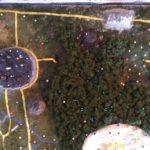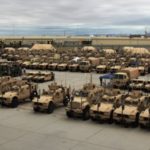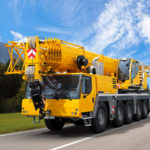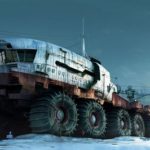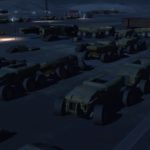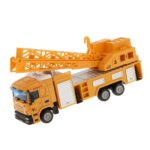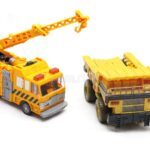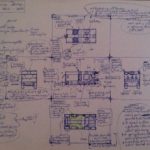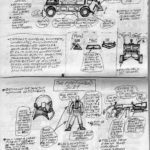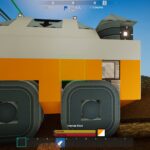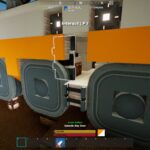Originally, there was only one of these gated parking areas for our city/race‘s only municipal/construction vehicle, and now there are several.
–
Table of Contents:
- Introduction
- Dimensions
- Work-horse Aspect Details
- Work-horse Usage
- Special Features
- Time to Construct
- History
- Location (Images Begin)
- Appearance
- Design
- Crew: Inisfreean Construction/Maintenance Workers
- 2023 Update: Full-size Model in Creativerse
- 2023 Update 2: Light-bars
–
Introduction:
Motor-pools double as biomechanical birthing factories; vehicles are not just stored here in a gated parking lot staffed by seasoned mechanics; vehicles in Inisfreean motor-pools are also ‘grown’ there, sometimes being ‘sung’ into existence, rather than fabricated on assembly lines. (This is based on our next-gen’ 3D-printing technology.)
–
Dimensions:
These vehicles have the same measurements as one of our “White Rhino” APCs (WRs).
- 50′ “long” (deep)
- 15′ wide
- 16′ tall
- tires: ~8′ diameter
- wheels: ~2′ diameter
- axels: ~1′ diameter
–
Work-horse Aspect Details:
Work-horses (WH) are the go-to vehicles in Inisfree for all maintenance and construction needs when using the science of creation via sounds (acoustics and harmonics) is not appropriate; sometimes lower technology approaches are prudent, sometimes it is more challenging to attempt to silence all construction sounds in an area by canceling them out with other sounds, and sometimes it is merely a matter of demonstrating alternative approaches for instructional purposes.
When it is time to use one of these city service vehicles, they bring a variety of tools to any job site:
- backhoe
- bracing legs
- bulldozer and excavator bucket-arm
- cattle-guard
- combine arm (for harvesting grain crops)
- crane (M-88 “Hercules” Recovery Vehicle style) –and its counter-weight slides closer or farther from the mount/turret/hinge based on need
- dump-truck bed (may be used for crops harvesting)
- fire-hose (and water tank) for intermediate-pressure cleaning
- forklift
- ground-penetrating RADAR (RAdio Detection And Ranging)
- high-pressure water-drill (from same water tank as the fire-hose)
- industrial-strength air pump
- laser-scalpel
- light-bar of orange and white LEDs
- nanobot slush tank (for spray-on and pump-in recycling ‘goo’)
- plow (includes snow-blower and laser that work together to expedite snow removal)
- ‘smart’-tires (which change their tread patterns and groove depths, as well as their air pressure, for ideal traction –just as can be done with Outlands vehicles such as the Sherp ATV)
- steamroller barrel-wheel (vertically retractable)
- street-sweeper brushes
- trash compactor (usually just for vacuumed-up fallen leaves, but it works on any trash)
- water-nozzles (in addition to the crane-mounted fire-hose); at the vertices and other spots along the 4 long-sides
- winches (front and back)
Workhorse vehicles can adjust their water hoses so that they spray out warm water capable of melting ice. Ambient-temp’ water is just what is defaulted to when a water-temperature doesn’t matter.
–
Work-horse Usage:
Because every Inisfreean construct is self-repairing, easily fine-tune-able by the Governor, and generally invincible (you won’t find any planned obsolescence in Inisfree), Work-horses are almost solely used in the Cropland region for the planting, harvesting, and rotating of Inisfree’s crops. These vehicles are especially useful at re-positioning larger trees, for example.
* For reference, though, Work-horse vehicles can be used for all of the following:
- bulldozing
- clean-up and sterilization operations
- construction (via 3D-printing)
- crop planting and harvesting
- debris disintegration
- demolitions
- drilling and core sampling
- flooding clean-up and water-table adjustment
- heavy lifting (via its crane)
- landscaping
- plowing (and plowing through obstacles)
- roadway maintenance and repair (including sweeping and flattening; steam-rolling)
- site surveying
- soil analysis and alteration
- terra-forming and earth-moving
- trash pick-up and disposal (in-compactor nanobot application instead of using city dumps)
- trenching and fire-fighting assistance
Only Inisfreeans (ICVs) are allowed to (and able) to drive/operate these vehicles. (They don’t start/function for anyone else, by design).
–
Special Features:
WH and WR wheels do not turn like a normal car; they are individually rotated at different speeds to turn the vehicle that other way.
–
Time to Construct:
It takes ~1 day to 3D-print one of these vehicles. That means that every hour… another ~4.2% of a WH gets completed.
- ~4 hours; hours 1 through 4: “bones”; frame/skeleton
- ~4 hours; hours 5 through 8: “tendons”; secondary conduits/pipes, etc. (as the frame/skeleton is based on the Grid Mind mesh/tentacles; the frame of every Inisfreean vessel/construct doubles as its plumbing and electrical wiring)
- ~4 hours; hours 9 through 12: “muscles”; hatches, crane motors, etc.
- ~4 hours; hours 13 through 16: “organs”; repulsines, Vril reactor/batteries, etc.
- ~4 hours; hours 17 through 20: attachments; ‘grill’/guard, scoop/s, bracing ‘legs’/extenders, etc.
- ~4 hours; hours 21 through 24: personnel; Inisfreeans (ICVs) stationed in its cab (yes, they are printed right inside where a human driver would sit to drive a normal truck)
–
History:
With the Grid Mind tentacles and ICVs handling almost all of the pruning, trash removal, and other city services / upkeep, these heavier-incident / cleanup vehicles were seldom needed. We decided to 3D-print another ~10 of them each year until our motor-pools of them were full. After that, we only printed more as-needed; whenever there were big municipal projects requiring their plows, scoops, or cranes, etc..
- 2012: ~10, and 1 WH motor-pool (shown on the city’s main map)
- 2013: ~20
- 2014: ~30
- 2015: ~40
- 2100: ~850 (now spread out evenly across 1 WH motor-pool for each neighborhood; ~30 motor-pools, thus ~28 WHs at each)
- 2200: ~900
- 2300: ~910
- 2400: ~920
- 2500: ~930
- 2600: ~940
- 2700: ~950
- 2800: ~1,000 (~1 WH for every square-mile of Inisfree within the perimeter wall)
- 2900: ~1,100
- 3000: ~1,200
- 4000: ~1,300
- 5000: ~1,400
- 6000: ~1,500
- 7000: ~1,600
- 8000: ~1,700
- 9000: ~1,800
- 10000: ~1,900
- 11000: ~2,000
- 12000: ~2,100
- 13000: ~2,200
- 14000: ~2,300
- 15000: ~2,400
- 16000: ~2,500
- 17000: ~2,600
- 18000: ~2,700
- 19000: ~2,800
- 20000: ~2,900
- 21000: ~3,000
- 22000: ~3,100
- 23000: ~3,200 (~106 WHs at each of our still-30 motor-pools for them)
In keeping with The Inisfreean Way, King Auz ‘christened’ every one of these vehicles as they came online, enjoying several ICVs on-duty as construction/cleanup-workers in each WH at that time, and this doubled as christening and re-christening their motor-pools.
–
Location:
–
Appearance:
–
Design:
–
Crew: Inisfreean Construction/Maintenance Workers
–
2023 Update: Full-size Model in Creativerse
Picture that whole vehicle as construction-orange, and with LED light-bars on the top, front, sides, and back.
–

–

–

–

–

–
2023 Update 2: Light-bars
–
Also see:
- “Printing Homes”; Apis Cor debut –because every Work-horse’s crane is fitted with 3D-printing devices
–

